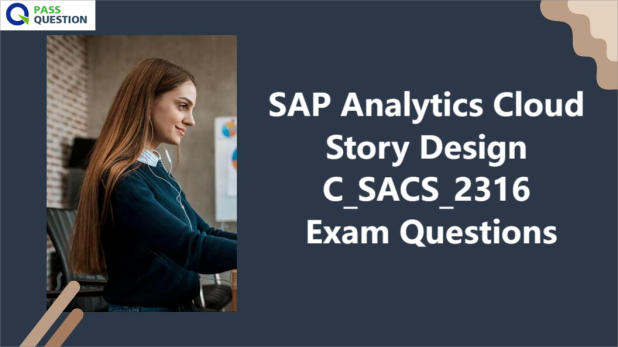SAP Analytics Cloud Story Design C_SACS_2316 Exam Questions
The C_SACS_2316 certification exam is a crucial step for individuals aspiring to become a SAP Certified Application Associate in SAP Analytics Cloud Story Design. To ensure your success in the SAP C_SACS_2316 exam, PassQuestion offers a comprehensive collection of the latest SAP Analytics Cloud Story Design C_SACS_2316 Exam Questions which cover all the essential topic areas, providing you with a solid foundation and boosting your confidence in passing the exam with flying colors. With our SAP Analytics Cloud Story Design C_SACS_2316 Exam Questions, you can enhance your understanding, improve your skills, and maximize your chances of success. Trust PassQuestion to guide you towards achieving your certification goals and unlocking new opportunities in the field of SAP Analytics Cloud Story Design.

C_SACS_2316 Exam Description - SAP Certified Application Associate - SAP Analytics Cloud Story Design
The "SAP Certified Application Associate - SAP Analytics Cloud Story Design" certification exam verifies that the candidate possesses the fundamental and core knowledge required of the SAP Analytics Cloud Story Design Consultant profile. This certification proves that the candidate has an overall understanding and technical skills to participate as a member of project team.The certificate issued for passing this exam will be valid for 5 years.
Exam Information
Exam Code: C_SACS_2316
Exam Name: SAP Certified Application Associate - SAP Analytics Cloud Story Design
Exam: 60 questions
Cut Score: 72%
Duration: 120 mins
Languages: English
Topic Areas
Configuring story elements > 12%
Manipulating data in stories > 12%
Story principles and presentation > 12%
How to Pass the SAP Analytics Cloud Story Design C_SACS_2316 Exam?
To pass the SAP Analytics Cloud Story Design C_SACS_2316 Exam, it is recommended to follow these steps:
1. Familiarize yourself with the exam objectives and content. Take the time to understand what topics and skills will be covered in the exam. This will help you prioritize your study efforts and focus on areas that are most important.
2. Create a study plan and allocate dedicated time for exam preparation. Set aside specific blocks of time in your schedule to study for the exam. Treat your exam preparation like a priority and make sure you have enough time to cover all the necessary material.
3. Utilize official SAP documentation and study guides for in-depth understanding of the topics. SAP provides official documentation and study guides that are specifically designed to help you prepare for their exams. Take advantage of these resources to gain a comprehensive understanding of the subject matter.
4. Practice with SAP Analytics Cloud Story Design C_SACS_2316 Exam Questions to assess your knowledge and identify areas for improvement. Practice exams are a great way to test your knowledge and get a feel for the types of questions that may be asked on the actual exam. Use these practice exams to identify weak areas and focus your study efforts accordingly.
5. Practice hands-on exercises to gain practical experience with SAP Analytics Cloud Story Design. Hands-on practice is crucial for developing your skills and gaining practical experience with the exam material. Look for opportunities to work on real-world projects or exercises that allow you to apply what you have learned.
6. Use mock exams or sample questions to simulate the exam environment and assess your readiness. Mock exams and sample questions are a great way to simulate the exam environment and gauge your readiness. Take advantage of these resources to get a feel for the exam format and identify any areas where you may need additional study.
View Online SAP Analytics Cloud Story Design C_SACS_2316 Free Questions
1. How can you improve performance in stories? Note: There are 2 correct answers to this question.
A.Use Exception Aggregations.
B.Use unbooked data in charts.
C.Minimize the number of linked models.
D.Use JPG images.
Answer: B, C
2. What can you do in the SAP Analytics Cloud mobile app? Note: There are 2 correct answers to this question.
A.Collaborate with colleagues
B.Create a story
C.Share Links
D.Create a dataset
Answer: A, C
3. You are using a model that includes a prompt. When is the prompt presented at runtime?
A.Before data can be displayed
B.Before predefined widgets are rendered
C.After navigating to the widget based on the model
D.After all widgets are rendered
Answer: A
4. When converting a story to Optimized Design Experience, what happens if the story contains elements that are not yet supported?
A.You receive a warning with information about what you must change.
B.The unsupported elements are deleted.
C.The unsupported elements become placeholders.
D.You receive a warning that the story will be deleted.
Answer: B
5. Which of the following is a story guideline?
A.Avoid the Top N feature in charts and tables.
B.Design many stories with few pages.
C.Avoid chart filters with many data points.
D.Design few stories with many pages.
Answer: B
6. What can you do in the SAP Analytics Cloud mobile app? Note: There are 2 correct answers to this question.
A.Collaborate with colleagues
B.Create a story
C.Create a dataset
D.Share Links
Answer: A, D
7. Which sort options are available in stories?Note: There are 2 correct answers to this question.
A.Ascending and descending order
B.Dimensions and measures together
C.Multiple dimensions together
D.Multiple measures together
Answer: A, C
8. What is a unique quality of viewing stories on a mobile device?
A.Stories render only in landscape mode for phones.
B.Stories do not rotate their orientation.
C.Stories rotate their orientation as you rotate the device.
D.Stories render only in portrait mode for tablets.
Answer: B
- TOP 50 Exam Questions
-
Exam
All copyrights reserved 2025 PassQuestion NETWORK CO.,LIMITED. All Rights Reserved.

